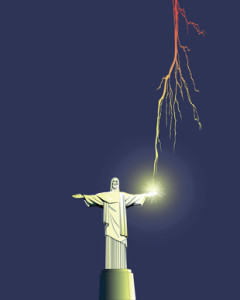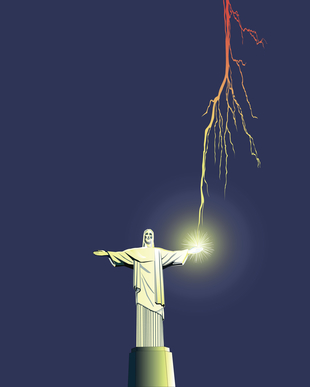
Despite the opposition of the most influential resident of the parish, William M’Culloch became the minister at Cambuslang, Scotland on April 29th, 1730. He would remain as the minister of the church in Cambuslang until his death forty years later. M’Culloch was a capable and faithful minister, notable for his learning and piety, but he was not an eloquent preacher. Even his son said his father was not “a very ready speaker.” This lack of eloquence was significant for the “Cambuslang work” in 1742; it could not be attributed to his preaching. You never heard of Cambuslang? George Whitefield looked upon the “Cambuslang work” as the greatest revival he ever witnessed.
About five miles from Glasgow, the size of the Cambuslang parish was roughly 900 by 1742, and it had a long association with evangelical faith. M’Culloch would rise and study from 5 a.m. to 8 p.m., allowing 2 or three hours for relaxation during that time. He also spent some of this time in private prayer. M’Culloch had been preaching on the doctrine of regeneration and newness of life to his congregation for about a year before the initial awakening in February of 1742. A narrative drawn up by M”Culloch in 1742 confirmed this practice.
After the Sunday evening sermon, M’Culloch would read to his congregation from the accounts of the ministry of George Whitefield, Jonathan Edwards and others. A Narrative of Surprising Conversions, by Edwards, was first published in London in 1837. It described the process of Christian conversion and the beginning of the Great Awakening in Northampton Massachusetts. Whitefield’s Journals were first published separately between 1738 and 1741. George Whitefield had been on a preaching tour to America, which was covered in his fifth Journal. You can read a copy of D. MacFarlane’s The Revivals of the Eighteenth Century, which highlights Cambuslang here; and The Journals of George Whitefield here.
So the revival in Cambuslang came to an informed people. They had been reading and hearing about revival in other places, and were prayerfully hoping it would happen with them. For several months before the Cambuslang Awakening, M’Culloch preached to crowded congregations. There was a more than ordinary concern about religion evident among his people. Whitefield himself had preached in Scotland during the summer of 1741, but he had not yet been to Cambuslang.
M’Culloch wrote to Whitefield of the fruit of his work, noting where fifty persons were “savingly converted” through the power of his sermons in the Glasgow area. MacFarlane said that many of those who afterwards who were “brought under the power of the truth” at Cambuslang, spoke of these sermons by Whitefield as among the first means to awaken in them a concern for their salvation. M’Culloch noted the immediate visible fruits were seen in the visible reformation of former sinners. Some individuals who had been known for their swearing and cursing now didn’t. Others who drank to excess were sober. Among the people, there was also a forgiveness of injuries, a making of restitution for harms done, and more.
An air of expectancy increased throughout the parish of Cambuslang as the winter of 1741 progressed. One woman was “much and oft” taken up in praying for a revival of Religion so that she seemed in a great measure to forget herself and her own concerns. Then on February 14th, a Sabbath, it began when a young woman of seventeen, Catherine Jackson, came under extreme conviction and distress, and was escorted from the service. M’Culloch counseled with her for about three hours afterwards. She had several semi-hysterical outbursts, convinced that her sins were too many to be received by Christ.
Catherine was finally calmed in prayer, saying that Christ had told her that He cast all her sins behind her back. There were many other people in the room, including several of her friends and her two sisters. Many of these others were also weeping and crying out. The next few days saw the repeat of similar circumstances of spiritual counseling. That Thursday, February 18th, M’Culloch preached on Jer. 23:6. About fifty men and women sought out the minister afterwards for prayer and conversation.
Afterwards, crowds of people came to Cambuslang. Sermons were provided almost daily. Several of the local ministers assisted M’Culloch in the teaching and exhorting of the ever-growing crowds. Other ministers traveled from distant parts of Scotland to participate in Cambuslang. Afterwards they sent attestations of the genuineness of the work to their own people. Whitefield was among the first to receive the news about Cambuslang. He hoped upon his return to Scotland to see “greater things than ever.” M’Culloch, in a letter to Whitefield at the end of April, said he was still holding daily sermons and longed to see Whitefield at Cambuslang. His hope was soon realized.
On Tuesday, July 6, Whitefield came to Cambuslang, and preached three times: at two, six and nine o’clock. The attendant commotion far outdid all he ever saw in America. The weeping and distress of the people—smitten by the scores—was beyond description. Whitefield likened it to a battlefield, where those struck were carried off and brought into the house like wounded soldiers. Throughout the entire night prayer and praise was still heard in the fields where Whitfield had preached. M’Culloch invited Whitefield to assist at the annual communion service scheduled to occur that weekend.
Whitefield preached to twenty thousand people on Saturday. He also preached on the Sabbath and again on Monday. Each day the crowd was approximately twenty thousand. Whitefield said on Monday, the motion passed “swift as lightning” from one end of the audience to the other. Thousands were bathed in tears; others wringing their hands; some almost swooning; others crying and mourning over a pierced Savior. The communion service was so impressive, that contrary to the church custom of yearly times of communion, Dr. Webster of Edinburgh, proposed that a second one be held soon. A decision was reached by the Cambuslang session of elders to again dispense the sacrament again on August 15th.
The second sacrament saw crowds even greater than at the first; upwards of 30,000 people came. For comparison, the estimated population of the city of Glasgow in 1740 was only 17,034! There were three thousand communicants, and another thousand who could not get tokens. Someone wanting to participate in the communion service but who was from another parish (and thus not known by the presiding minister) would receive a lead token from their own minister. The token represented them as a member in good standing and approved to receive communion by their own minister.
The Sunday worship began at 8:30 in the morning, and the last communion table was being served at sunset. One of the original Marrow Men, John Bonar, then 72, was present as an assisting minister. He was an ancestor of the distinguished Bonars of the eighteenth century: Horatius, John and Andrew. His health was so frail that it took him three days to ride the eighteen miles from his home to Cambuslang. This second communion was the high-water mark of the Cambuslang revival. Whitefield said: “Such a passover has never been heard of.” Whitefield thought it was the greatest revival he had ever witnessed.
The great scandal of religious enthusiasm during the Enlightenment, an Age of Reason, meant that the news about Cambuslang spread like wildfire. There were faintings, outcries, and “bodily agonies.” A nineteen year-old youth couldn’t walk or speak, and scarcely could draw his breath. A woman had pains under spiritual conviction akin to those of childbirth. Another woman frightened her poor husband when she roared out twice in a manner not like a human, after family devotions. She had trembling and a terrible thirst; smelled an odor she associated with the Bottomless Pit. A man said his body was almost taken off from the place where he was. He remained in this state about two hours, then had a vision akin to that of Ezekiel in the valley of dry bones, followed by another of a shower of manna.
Concern over the physical manifestations at Cambuslang raised the fear of the spirit of Quakerism, crypto-Camizards (French Prophets), or other enthusiastic sects. So the “Cambuslang Wark” was disparaged. In a testimony dated April 30, 1751, M’Culloch admitted that in 1742 there were many who fell under various bodily agitations and commotions. He stated that we cannot conclude that such persons were under the influence of the Spirit. These agitations could have been a result of the power of the imagination, or from a bodily disorder. He cautioned that no one should suspect themselves, merely because they had not experienced such effects.
Conversely, we cannot infer that the because of such effects, the cause was not divine. Referring to the crying out during worship, he said it was best to avoid extremes. Hearers should resist the urge if they can (and not disrupt the service). Preachers should not encourage such expressions, nor rebuke them too severely. He noted how God had used such outcries to contribute to the awakening of others. He noted how some who tried to restrain themselves from crying out began bleeding from the mouth and nose, continuing for some time to the injury of their health and the alarm of all nearby. MacFarlan, author of Revivals of the Eighteenth Century, argued that tears, groaning, fainting and even strong bodily agitations should be expected effects to those brought to the conviction of their sin. He suggested that the crowds response at Pentecost was probably similar to that of Cambuslang; the bodily agitations are the natural effects of such feelings as are here expressed.
A true assessment of the reality of a revival is the fruit that it bears, and Cambuslang did have it. One example was evident to visitors of Cambuslang. They were impressed by the warm affection and sense of community found among the residents. Above we noted the changes in the live of sinners: the profane became reverent; the drunkards became sober. However, the telling fruit of any revival is the Christ-likeness of the participants: those who truly love Christ will do as he commands. On April 22, 1751, M’Culloch compiled a list of four hundred awakened in the 1742 revival, who had continued from then until their death, or until 1751 to behave in a good measure “as becometh the gospel.” He had been careful to gather his information by either personal observation, or written and verbal information from persons of established character who knew those of whom they report.
The above experiences at Cambuslang sound much like those associated with the Toronto Blessing of twenty years ago. But we should remember that Cambuslang happened in a time when the experience of high or intense “religious affections” was suspect; perhaps even more so than today. Additionally, they occurred within the context of a Presbyterian communion service. I think the following quote from Thoughts on the Revival, by Jonathan Edwards gives a balanced perspective on the existence and experience of these religious phenomena.
There is a great deal of difference in high and raised affections, which must be distinguished by the observer. Some are much more solid than others. There are many exercises of the affections that are very flashy, and little to be depended on; and oftentimes a great deal appertains to them, or rather is the effect of them. . . . that which sometimes more especially obtains the name of passion, is nothing solid or substantial. But it is false philosophy to suppose this to be the case with all exercises of affection in the soul, or with all great and high affections; and false divinity to suppose that religious affections do not appertain to the substance and essence of Christianity. On the contrary, it seems to me that the very life and soul of all true religion consists in them.





